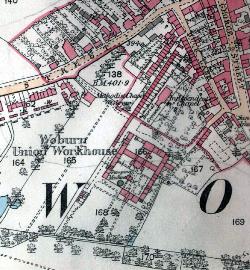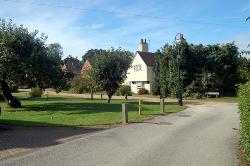Woburn Union Workhouse
Under the original Poor Law of 1601, parishes collected a Poor Rate from those inhabitants not amongst the poor. This rate was collected and administered by a parish official - the Overseer of the Poor (larger parishes had more than one Overseer). He  made disbursements of money or food and/or clothes to people who needed it. This was known as giving relief and this relief could be of two types. Outdoor relief was given to people who had their own lodgings and could maintain themselves in them with assistance. Indoor relief was granted to people who either had no dwelling, or were incapable of looking after themselves, this meant that they entered the parish poorhouse or workhouse.
made disbursements of money or food and/or clothes to people who needed it. This was known as giving relief and this relief could be of two types. Outdoor relief was given to people who had their own lodgings and could maintain themselves in them with assistance. Indoor relief was granted to people who either had no dwelling, or were incapable of looking after themselves, this meant that they entered the parish poorhouse or workhouse.
When the word workhouse is used people normally think of the large, grim 19th century institutions housing hundreds of people in ways not dissimilar to a prison. Such institutions were created by the Poor Amendment Act of 1834. Before this certain larger parishes had their own workhouses which catered simply for the parish. Woburn had such a parish workhouse from 1734.
Then in 1834 Woburn was chosen as the site for a Union Workhouse. These were so called because they were the focus of a Poor Law Union of a number of parishes. In the case of Woburn these were: Aspley Guise (and later Aspley Heath); Battlesden; Chalgrave; Harlington; Hockliffe; Hulcote; Husborne Crawley; Milton Bryan; Potsgrove; Salford; Ridgmont; Tilsworth; Tingrith; Toddington and, of course, Woburn itself. From the 1840s the Overseers tended no longer provided outdoor relief (because it was officially discouraged, though never made illegal), the money they collected now going to the Union to help maintain the poor of that parish in the Union workhouse.
Woburn was a very small union and Bedfordshire & Luton Archives & Records Service does not have many records for it, the following being a complete list:
PUWL: Ledgers
PUWL1: General, parochial and non-settled poor ledger: 1835-1837;
PUWL4: General, parochial and non-settled poor ledger: 1845-1848;
PUWL5: General, parochial and non-settled poor ledger: 1848-1851;
PUWL10: General, parochial and non-settled poor ledger: 1868-1873;
PUWL13: General ledger, including non-settled and non-resident poor: 1899-1902;
PUWL14: Parochial ledger: 1879-1891
PUWM: Minutes
PUWM1: indexed, 1835-1837;
PUWM2: indexed, 1838-1840;
PUWM4: indexed, 1843-1847;
PUWM5: indexed, 1847-1850;
PUWM6: indexed, 1850-1855;
PUWM7: indexed; 1855-1860;
PUWM8: indexed, 1860-1865;
PUWM9: index 1866-1871;
PUWM10: index 1871-1878;
PUWM11: index 1878-1888;
PUWM12: index 1888-1895;
PUWM13: index 1895-1902
PUWMC: Committee Minutes
PUWMC1: School Attendance Committee dealing with all schools in the Union: 1877-1899
Woburn Poor Law Union was never efficient and was dissolved on 26 Sep 1899 with most parishes being transferred into Ampthill Union, the exceptions being Chalgrave, Hockliffe and Tilsworth which were transferred to Leighton Buzzard Union.
The following report is from the Bedfordshire Times of 15 Dec 1899: "SALE OF THE WOBURN WORKHOUSE. - On the 8th inst. the closing scene in the history of the now dissolved Woburn Union , which has played so important a part in the chronicles of the town during the last seven decades of the century, took place at the Bedford Arms Hotel, when the freehold was put up for auction. Messrs. Swaffield and Son offered this desirable freehold with about three acres of land in one lot. The auctioneers had circulated descriptive particulars giving minute information as to size and numbers of apartments and rooms contained in the workhouse block and outbuildings, drawing special attention to the opportunity afforded for converting the buildings into a factory or other hive of industry which should be the starting point towards reviving the now flagging trade of Woburn. A large company attended the sale, among them being some who were certainly "unknown" to the townsfolk. This at least looked "promising", some of the elders remarked, and their expectations rose accordingly. Visions of a bright future for Woburn began to rise before their eyes, which were, however, broken into by the auctioneer (Mr.H.R.J.Swaffield) calling their attention to the business before them, and after a few introductory remarks the bidding commenced at £1,000. Subsequent bids quickly doubled this amount, and the bidding gradually rose to £3,000, at which price Mr.Woods, of London, became the purchaser, as agent for His Grace the Duke of Bedford, who now owns nearly the whole of the freeholds in the town. This purchase will give His Grace an extensive slice of the central portion of the town, and we met yet live to see model dwellings rise on the ashes of the "poor house". Mr.W.H.Smith (clerk to the late Woburn Union) acted as solicitor, and the sale was ordered by the late acting guardians of the union".
The auctioneers need not have bothered giving their " minute information as to size and numbers of apartments and rooms" since the buildings did not long survive - they were pulled down and the "model  dwellings" in London End and Bloomsbury Close now stand on the site. However, it is fortunate for the local historian that such pains were taken. Bedfordshire & Luton Archives & Records Service has a bundle of documents in the Swaffield collection [SF75/24] relating to the sale including detailed inventories of room contents. The sale particulars [SF75/24/12] note that the workhouse covered 3 acres and the property is described as "very desirable freehold brick, tiled and slated building known as The Woburn Union Workhouse". The particulars list the structure as follows:
dwellings" in London End and Bloomsbury Close now stand on the site. However, it is fortunate for the local historian that such pains were taken. Bedfordshire & Luton Archives & Records Service has a bundle of documents in the Swaffield collection [SF75/24] relating to the sale including detailed inventories of room contents. The sale particulars [SF75/24/12] note that the workhouse covered 3 acres and the property is described as "very desirable freehold brick, tiled and slated building known as The Woburn Union Workhouse". The particulars list the structure as follows:
Ground floor: entrance hall (23ft by 16ft) with receiving wards and porter's room adjoining; chapel (45.5 by 20); dining hall (53 by 16); five day rooms (23 by 16, 20 by 15, two of 16 feet square and 16 by 11 respectively); clothing store; kitchens, sculleries and pantries; officers' quarters including dining hall and offices; large bakehouse fitted with patent 5-bushel oven; shoemaker's shop; male and female vagrant wards; fever hospital; closets etc., "the whole enclosing 9 courtyards"
First floor: Board Room (23 by 16.5) with office, committee and strong rooms adjoining; spacious store room (26 by 18); 14 "large, well lighted and ventilated" dormitories and day rooms with wcs, lavatories and bathrooms; master's and matron's sitting rooms (15.5 by 12.5 and 15.5 by 11.5 respectively); nurse's sitting room and bedroom; master's and matron's bedrooms; schoolmistress' sitting room and bedroom; kitchen etc. fitted with hot water apparatus
Outbuildings: "useful range" of timber and slated buildings divided into barn, stable, cart shed and stone breaking sheds and 4 brick and slate pigsties; extensive kitchen gardens.
A story about a crooked errand boy from the workhouse in 1843 can be found on a linked page.